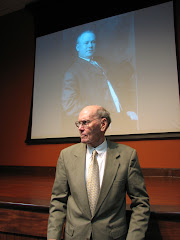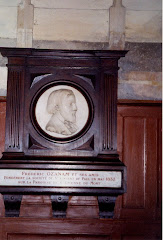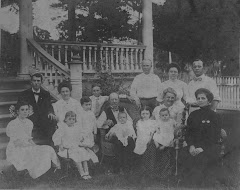First Item of Interest
In searching for the Morgan connection to Chief Justice Roger B. Taney, I discovered a Lancaster connection. We have a common ancestor, Robert Brooke. (I imagine if you go back far enough, you can find that with just about anyone.) Taney was the son of Michael V. Taney V and Monica Brooke. Monica Brooke's father, grandfather, and great-grandfather were all named Roger Brooke. Roger Brooke the great-grandfather (1637-1700) married Dorothy Neale (1646-1680). The Neale name arises in our ancestry, too, but that isn't the immediate connection. Roger Brooke's parents were Robert Brooke (1602-1655), a colonial governor of the Maryland colony, and Mary Mainwaring (1610-1663). They married on May 11, 1635, one year after the death of Robert Brooke's first wife, Mary Baker (1607-1634). Robert Brooke and Mary Baker are our ancestors. Their son, Baker Brooke (1628-1679) married Anne Calvert (yes, a descendant of the founder of Maryland; 1644-1714). Their daughter, Mary Brooke (1680-1763), married Raphael Neale (1683-1743). Their daughter, Elizabeth Neale (1704-1762) married Captain John Lancaster (1673-1760). Their son, Raphael Lancaster (1732-1802), married Ellinor (Eleanor ?) Bradford (1735-1802). Their son, John Lancaster (1766-1838), married Catherine Miles (1772-1847). They had twelve kids. Their eldest, Joseph B. Lancaster (1790-1856), was our grandfather's grandfather.
It is worth noting that the Taney-Brooke family stayed in Maryland through all of the births and deaths listed above. (That is, after Robert Brooke moved to Maryland at the behest of Lord Baltimore to command a new county, Charles County. Robert Brooke's first wife -- our ancestor -- had died in England. His second wife and all of his children and servants -- 40 in all -- sailed to Maryland in 1650 [source: Pennsylvania Society of Colonial Governors, Volume 1, copyright 1916, accessed through Google Books.com.])
In the same span of time, our branch of the family closely parallels the history of our country after Independence. Raphael Lancaster moved with his family to Bardstown, Kentucky, as part of the massive migration of white settlers to what was then called the West -- the trans-Appalachian region settled after the Revolutionary War. His son John was captured by Indians. Read the account in the old family history that Bradford Lancaster and Edith Lancaster Garcia prepared for the 1976 reunion in Covington. That capture, too, is reflective of our nation's history as Indians in the Ohio Valley opposed white settlement and fought it until the Indians were driven out by war, disease, and forced migration.
John's son, Joseph B. Lancaster, led a company of Kentucky calvary intent on fighting the British in the War of 1812 in the Great Lakes theater. By the time the company arrived in Detroit, the war had ended. As noted in the recent blog entry, Joseph and his family moved to Florida from Kentucky, perhaps at the urging of a friend from Bardstown, William Pope Duval. A more encompassing reason may have been why many Kentuckians and Tennesseans moved to Florida -- General Andrew Jackson became military governor there after Florida became part of the U.S. Later, Joseph B. Lancaster fought against the Seminole Indians. He was wounded in the neck and retired to the less dangerous combat of politics.
William B. Lancaster, Joseph's son, is responsible for the Louisiana origins of the Lancasters. He had moved with his family to Florida from Kentucky, attended school at St. Joseph's in Bardstown then the University of Paris where he was converted to Catholicism by Frederick Ozanam. As many of our family know, William brought the Society of St. Vincent de Paul to Louisiana, where he organized a branch in New Orleans. His reasons for coming to Louisiana may be related to his work for the Society. Please see the plaque to Ozanam posted here that is in the church adjacent to the University of Paris, St. Etienne du Mont. The plaque is on a wall perpendicular to a side altar dedicated to St. Vincent de Paul. The photo was taken by a French woman as a favor to my sister, Edith Garcia Eason. Were it not for Ozanam, might we have all grown up in Florida?
Second Item of Interest
While looking up some of the above information, I found that the wife of Joseph B. Lancaster (our great-great-grandfather, not our grandfather), Ann Blair Lancaster, is buried at Arlington National Cemetery. She was living in Washington, D.C., at the time of her death in 1890. Burial there was due to her husband's service in two wars. Also buried in Arlington is William B. Lancaster's sister, Laura Louise Lancaster Vincent. As the 1976 history records, she was also converted to Catholicism and studied at the University of Paris. She married U.S. Army Lieutenant Thomas M. Vincent, who served as assistant adjutant general during the Civil War on the Union side. The fact that his brother-in-law, William B. Lancaster, was a member of the medical corps of the trans-Mississippi department of the Confederate Army is another specific example from our family of a larger historical trend, this one of how families were split by the Civil War. Vincent had become a brigadier general before his death in 1909. He is also buried in Arlington. He and his wife are in section Z -- she in 175LH, he in 175RH. I intend to contact Arlington National Cemetery's Freedom of Information officer to find out where Ann Blair Lancaster is buried.
Tuesday, September 1, 2009
Subscribe to:
Post Comments (Atom)




No comments:
Post a Comment